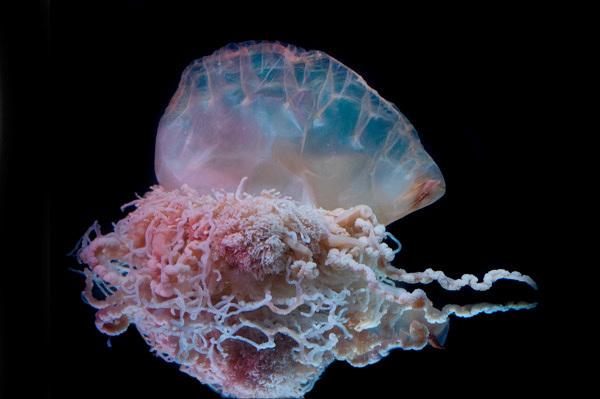Describe and name the 3 germ layers present in most animals, but not entirely present Cnidaria and Porifera.
Ectoderm: Outermost layer; gives rise to covering of animals (ex:skin) and nervous system.
Mesoderm: Layer in-between ecto/endoderms; gives rise to muscles and organs in the digestive tract.
Endoderm: Innermost layers; gives rise to digestive tract and organs like the liver and lungs.
True or False: Poriferas have a definite symmetry
False: Phylum Porifera does not have a definite symmetry. Mostly irregular and not symmetrical.
Fill in the blank. Can you name the Genus and Class?
Genus: Grantia
Class: Calcarea
True or False: Cnidarians have tissues, but no circulatory, reproductive or excretory systems.
True!
Define hydroskeleton.
A skeleton that relies on pressure fluid running throughout it's body which provides support and helps the animal move. Mostly seen in invertebrates.
Describe Symmetry and the 3 types that you have learned about in lecture.
Symmetry: The quality of containing exactly similar parts to each other or an axis plane.
Asymmetry: No plane that can be drawn for the organisms to have equal sides (ex: sponges)
Radial: Parts arranged in a balanced way around a central axis. (ex: sea anenome)
Bilateral: Parts can be divisible into equal or symmetrical halves. Includes anterior, posterior, dorsal, and ventral symmetry. (ex: humans)
Rather than tissues, poriferans have layers of what?
Poriferans have 3 layers which include the Epithelium, Mesohyl and Choanocytes.
Outer Epithelium: Houses the ostia, spongocoel and osculum.
Mesohyl: The gelatinous matrix that houses the Spicules and Spongin.
Choanocytes: Flagellated cells that face are shielded by the 2 outer most layers that capture and digest food as water passes through the ostia.
Fill in the blank. Can you also label the spicules? Name Genus and Class?
Class: Calcarea
Genus: Leucosolenia
If cnidarians do not have a centered nervous system, how can they still respond to their environment?
Rather than having a centered nervous system, they have a rudimentary nervous system which is a very basic nervous system that scattered across the body. They respond to environmental stimuli by capturing prey and digesting it.
Fill in the blank.
What is the difference between diploblastic and triploblastic?
Diploblastic: An organism that of ectoderm, endoderm and mesoglea (a nonliving gelatinous layer in cnidarians).
Triploblastic: An organism that typically contains a body cavity of ectoderm, endoderm and mesoderm.
Name and describe the 3 body types of sponges.
Asconoid: Spongocoel
Syconoid: Radiocanals
Leuconoid: Choanocyte chambers
Identify the class and 3 characteristics present in that class.

Class: Demosponage
1. Spicules made of silica
2. Contains spongin
3. Leuconoid body type
4. Marine and Fresh
5. Shallow to deep waters
What is the difference between Nematocysts and Cnidocytes?
Nematocysts: The spear like arrows inside the cnidocytes that fire towards prey, releasing a toxin that can be fetal.
Cnidocytes: The stinging cell.
Name the Class and describe 3 characteristics.

Class: Hydrozoa
1. Contains both polyp and medusa stage.
2. Contains freshwater living members.
3. Obelia
4. Asexual reproductin via budding
5. Dominant polyp reduced medusa.
What is cleavage?
A series of zygotic cell division that does not require growth of the zygote. It will eventually become a multicellular embryo. You will later learn about Radial and Spiral cleavage.
How do sponges reproduce?
Asexual: Via Fragmentation
Sexual: Choanocytes become sperm and are then tranferessed to the egg cell in mesohyl. Zygote develops in mother or in open water and eventually becomes a free swimming larva. The larva will settle and become sessile for the rest of its life.
Identify the Class and 3 characteristics present in this sponge.

Class: Hexactinellida
1. Spicules made of Silica
2. No Spongin
3. Leuconoid
4. Marine
5. Lives in Deep waters
Cnidarians live in these 2 dominant body forms. What are those forms?
Polyp: A sessile and cylindrical stage that contain a single opening to the digestive tract with tentacles surrounding them.
Medusa: An umbrella shape and motile stage with the mouth hanging down the umbrella shaped body.
Name the Class and describe 3 characteristics.

Class: Scyphozoa
1. Reduced polyp stage
2. Dioecious
3. Rudimentary Muscle/Nerve System
What happens to a developing zygote as it undergoes cleavage?

Describe the image below.

Spicules
True or False: In Cnidarians, the medusa stage forms that gametes.
True!
What is the gastrovascular cavity of a cnidarian?
Is an area in the cnidarian that is lead by a single opening where it digest its foods with enzymes, gas exchange and releases waste.
Name the Class and describe 2 or 3 characteristics.

Class: Cubozoa
1. Most dangerous to humans, fatal stings.
2. Box Jellies